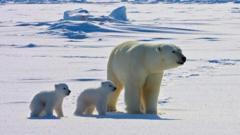In the rapidly warming Arctic, polar bears are confronting an alarming increase in health risks, particularly a rise in disease susceptibility due to climate change. A comprehensive study disclosed that over the past few decades, polar bears have encountered more viruses, bacteria, and parasites than they did thirty years ago, a change that correlates with the ongoing loss of their ice habitat.
Researchers from the US Geological Survey (USGS) conducted analysis on blood samples of polar bears from the Chukchi Sea, situated between Alaska and Russia, collected at two separate time periods: the late 1980s and early 1990s, and then again from 2008 to 2017. The results showed that a significantly greater proportion of recent samples indicated infections with various pathogens.
Wildlife biologist Dr. Karyn Rode, who led the investigation, emphasized the shift within the Arctic ecosystem, noting, “It is evident that something significant is changing." The team monitored six different pathogens, focusing on five of particular concern that had shifted from primarily land-based animals to impacting polar bears, including multiple parasites and bacteria.
Dr. Rode pointed out that while polar bears generally have robust immunity to disease, the current situation highlights a worrying trend as conditions in their habitats transform drastically. She stated, “We wanted to know if exposure had changed - particularly for some of these pathogens that we think are primarily land-oriented.”
With an estimated global population of about 26,000 individuals, polar bears are classified as vulnerable by the International Union for Conservation of Nature. The rising sea temperatures and consequent loss of ice are crucial factors contributing to their precarious status. As bears are forced to spend more time on land due to limited sea ice, their access to food diminishes, further exacerbating their vulnerability.
Previous studies involving collar cameras have helped to identify the dietary patterns of polar bears during ice-free summers and even captured intriguing social behavior. Dr. Rode pointed out that the exposure to pathogens mainly stems from their prey species, indicating that as polar bears adapt to their changing environment, other species are likely being affected too.
With the findings now published in the scientific journal PLOS One, this research brings to light the significant implications of climate change on the health of polar bears and serves as a reminder of the urgent need for conservation efforts in the Arctic region.





















